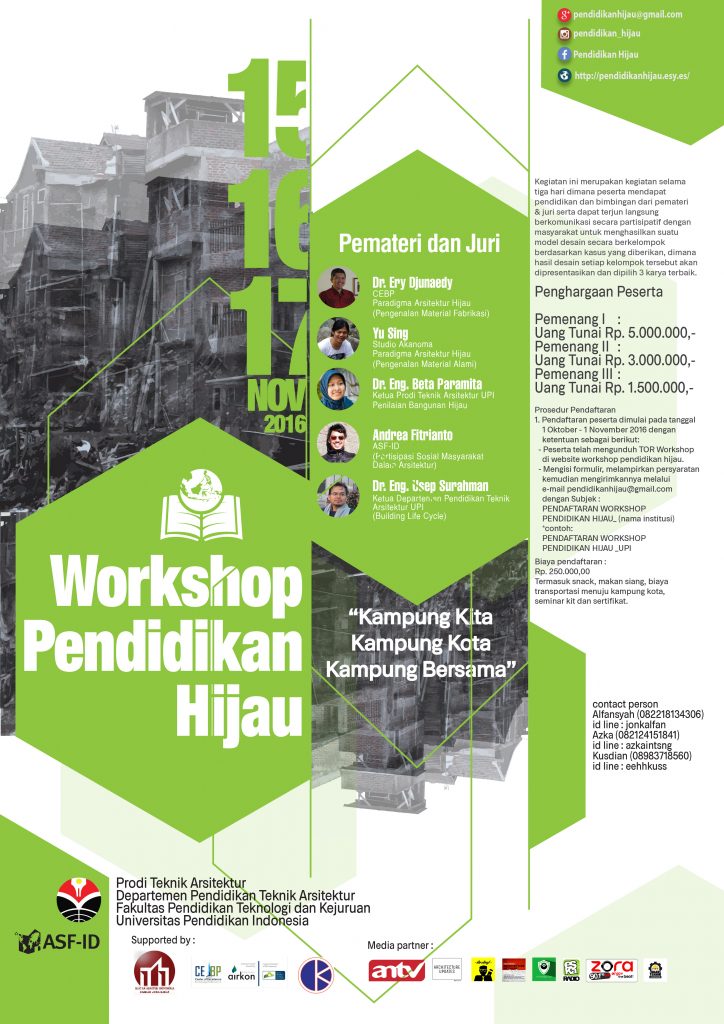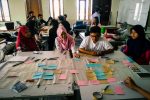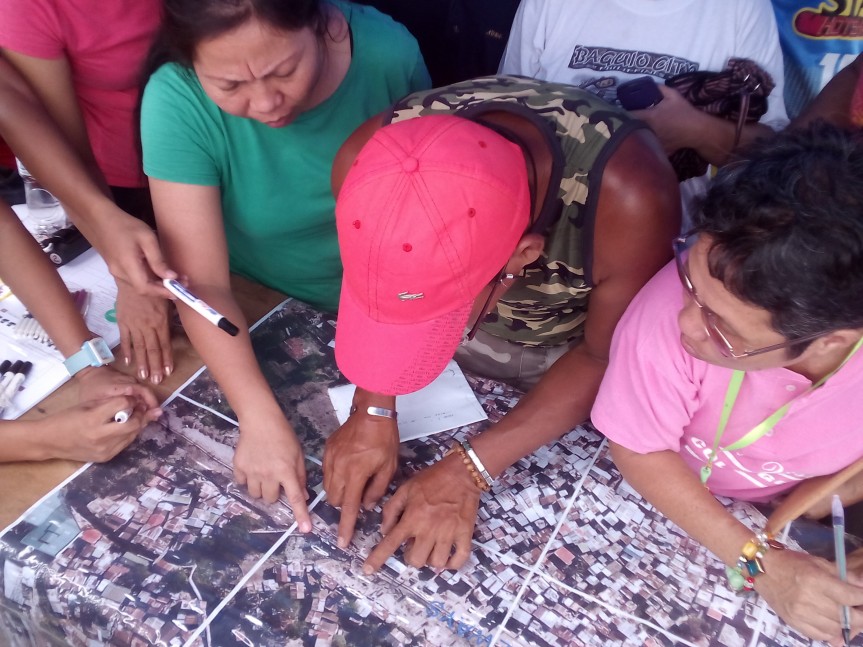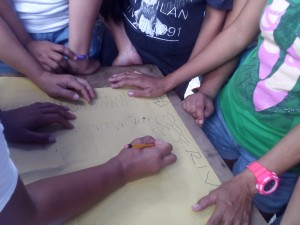 Metro Manila welcomed the national and international participants of 3rd Community Architects Network Regional Meeting and Workshop: Together We CAN …People Planning for Future Inclusive Cities on 16th of June 2015. The site visit around the historic walled city of Intramuros was preceded with a series of opening remarks and sharing session from all involved. The sharing session was a chance for international participants from South Africa, Bangladesh, Cambodia, Indonesia, Canada, China, South Korea, Italy, Thailand, Taiwan, USA, and Chile to share their endeavors.
Metro Manila welcomed the national and international participants of 3rd Community Architects Network Regional Meeting and Workshop: Together We CAN …People Planning for Future Inclusive Cities on 16th of June 2015. The site visit around the historic walled city of Intramuros was preceded with a series of opening remarks and sharing session from all involved. The sharing session was a chance for international participants from South Africa, Bangladesh, Cambodia, Indonesia, Canada, China, South Korea, Italy, Thailand, Taiwan, USA, and Chile to share their endeavors.
Ongoing and planned people-centered collectives’ projects were elaborated. Established groups shared their history and developments. Growing organizations stated their intention and future aspiration.
The various nationalities participants were representing Slum Dwellers International, Informal Settlement Network, Community Organisation Resource Centre, Federation of the Urban and Rural Poor, BRAC University, J.A. Architects Ltd, Bangladesh University of Engineering and Technology, Community Development Foundation, Arkomjogja, ASF Indonesia, University of Tokyo, University of California Los Angeles, CAN Korea, Toad Housing, Architecture Group [tam], Openspace, Ta-Saeng, Development Planning Unit of University College London, Sasaki Associates, and Massachusetts Institute of Technology.
The following week was then spent by the participants via working together on the ground with actual issues and communities; in Intramuros and Muntinlupa City.
| Community Architects Network (CAN) is a program under Asian Coalition for Housing Rights (ACHR) which started in 2009. For five years, CAN has been acting as an active platform linking architects, engineers, planners, universities and community artisans throughout Asia. The core idea of CAN is to work with communities in finding solutions to build better settlements and more inclusive cities.
The previous CAN Workshop in 2013, themed “People CAN make change”, was also organized in Philippine, specifically in Valenzuela City. Philippine is the home to groups and actors that have been working together for people-driven development. Among them, acting as coordinators is the Philippine Alliance; Homeless Peoples Federation Philippine (HPFPI), Technical Assistance Movement for People and Environment (TAMPEI), LinkBuild, Core-Acs, and PACSII.
|
The workshop is still emphasizing on the importance of taking on a citywide perspective to bring about change at a larger scale, but where communities and community solutions are key ingredients. Community Development Approach (CDA) then became a part of the dialogues.
“…the demonstration that people can truly make change
– CAN 3rd Workshop Handbook
During the workshop, 99 national and international participants were grouped to 6 teams. Two of the teams were stationed to work with informal settlements issue inside the heritage area of Intramuros. The others were stationed in multiple barangays (administrative divisions) of Muntinlupa City.
Intramuros
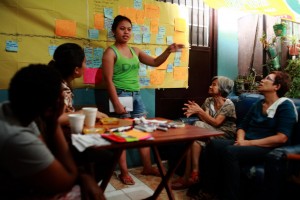 The workshop on heritage conducted at Intramuros is unique in the sense that it meant to challenge the mainstream notion of heritage conservation. In this case, heritage issues were also include facts relate with the residents within the walled city, that is the recent history of the so-called Informal Settler Families (ISF) who begun to dwell since as early as 1950 (Nanay Bising, Solana community).
The workshop on heritage conducted at Intramuros is unique in the sense that it meant to challenge the mainstream notion of heritage conservation. In this case, heritage issues were also include facts relate with the residents within the walled city, that is the recent history of the so-called Informal Settler Families (ISF) who begun to dwell since as early as 1950 (Nanay Bising, Solana community).
Within the last six decades big things happens to the ISF communities, for Solana this is including threat of demolition in 1997, land ownership claim filed and house demolition at the same year of 1998, fire in 2000 and 2003, as discussed during the community history workshop at Solana on Sunday, June 21st 2015. Individual stories gathered and shared during the workshop strengthen collective memory of Solana that is fundamental in building Solana identity and at the end to determine its future aspirations for community planning and upgrading.
Tuesday, June 23rd 2015 saw the ISF communities presenting their perspective and vision of conservation to a larger audience including Intramuros Administration, World Bank, representatives of land owners, architects, planner and other professionals concerned with Intramuros. The ISF communities in Intramuros have proven their capacity and ready to be part of conservation plan as well as city development agenda in general.
Muntinlupa City
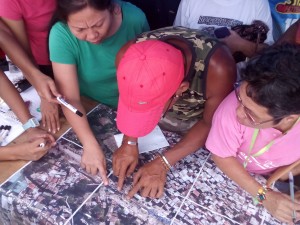 Muntinlupa is classified as a highly-urbanized city[1] located in the southernmost of Metro Manila. The different contexts given were proven to color the workshop with further questions and ideas of how people centered development could work with Local Government Units and multiple stakeholders. Three days of intensive direct involvement with communities were presented in Public Forums, held in Muntinlupa City on 22nd of June and Intramuros on the 23rd.
Muntinlupa is classified as a highly-urbanized city[1] located in the southernmost of Metro Manila. The different contexts given were proven to color the workshop with further questions and ideas of how people centered development could work with Local Government Units and multiple stakeholders. Three days of intensive direct involvement with communities were presented in Public Forums, held in Muntinlupa City on 22nd of June and Intramuros on the 23rd.
Due to the bureaucracy of the development, information issues become crucial. Communities affected by future development often have no clear grasp on their resources and government planning. The partnering communities are expected to know and understand how such programs may affect their living situations, immediately and gradually. The state of affairs can be achieved if relevant information is within reach. On the other hand, information as such must be clearly articulated by the government units. The platform for discussion among every parties involved should then respect possibilities that are socially and economically just.
Muntinlupa City with its nine Barangays is the pilot project of World Bank and Social Housing Finance Corporation’s CDA. Some communities had already gone through initial processes and some are in the line to start. The four workshop teams were located in the following Barangays: Sucat for Planning and Re-blocking Processes, Buli for Housing Program with the Barangay Officials, and Alabang for Initial Community Mapping. The teams were made known to a 2014-approved proposal of 47 km long Laguna Lakeshore Expressway Dike that would entail Laguna Lake west shoreline reclamation. The Expressway project would connect Taguig southward to Calamba and Los Baños.
One team in Sucat had assisted flood-prone Lakeshore Community in connecting between their land condition and status to available government plans. Residing on privately owned land, most of the communities are willing to purchase the land with Community Mortgage Program (CMP) from the government. The communities connect to the lake economically, therefore they also inquire for clearer information regarding Expressway Reclamation. They are open to on-site development or near-site relocation.
The other Sucat team had worked with Sitio Pagkakais, a village of mostly informal settlers on private land. The communities re-blocking plans had been approved by the city, as part of CMP requirements. The challenges arose from the plans that were incompatible with the actual conditions; various existing plots belong to the 368 families and permanent structures. Another challenges faced were plotting the main access ways into the area and addressing occupants that refuse to cooperate with the initiative.
The team located in Buli had worked together with the communities of approximately 162 households in a housing program with local Barangay Officials. The informal settlers’ with the assistance of the team had done participatory planning for the available 4.7 hectare land. The challenges faced were consolidating the communities’ vision and strategies and communicating them to the Barangay Officials.
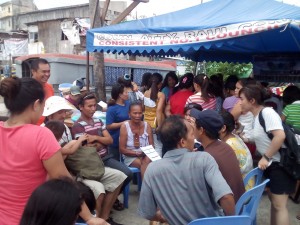 ASF Indonesia delegate was given the chance to work as facilitator along with HPFPI and TAMPEI participants with Alabang team. Comprised of local communities’ members and participants, the team had worked four intensive days with four compounds along the Alabang River Creek and Philippine National Railway. The four compounds consist of approximately 800 households. The team had introduced the objective and method of settlement profiling, participatory mapping and hands on training with communities’ members. Actual mapping and surveys had been done by the locals with the team assistance.
ASF Indonesia delegate was given the chance to work as facilitator along with HPFPI and TAMPEI participants with Alabang team. Comprised of local communities’ members and participants, the team had worked four intensive days with four compounds along the Alabang River Creek and Philippine National Railway. The four compounds consist of approximately 800 households. The team had introduced the objective and method of settlement profiling, participatory mapping and hands on training with communities’ members. Actual mapping and surveys had been done by the locals with the team assistance.
The team then provided technical support in encoding and validating the data. The phase would start five months project of community mapping as initial step to promote upgrading process to the Local Government.
The initial step of community mapping is as vital as the progressing steps. The media used by communities in order to gain understanding are mostly in the form of applied maps. Mapping is a method with which a community can easily take charge of their social and spatial knowledge, and then use it as a tool to negotiate their situation. The technical team aids further in terms of providing data validation.
To whom the city belongs? The presence of communities who actively live in and work to support the city does not necessarily signify their active ownership of the city development. The city planning needs to be inclusive; up close and accessible.
CAN 3rd Workshop have underlined the urgent need to work with disadvantaged city dwellers and multiple stakeholders. One of the keys to inclusivity is to introduce a language for the communities to recognize their living space, with the purpose of claiming their rights to dignified living; secured tenure, access to basic resources, chances to participate and decent sources of living. The language needs not to be complicated, but as humble as hands-on mapping, planning and resourceful aspiration proficiency.
[1] Philippine Republic Act No. 7926
